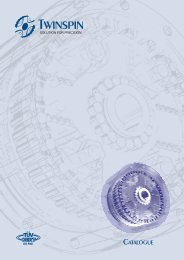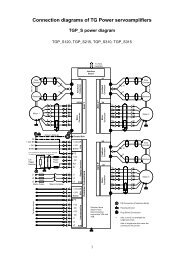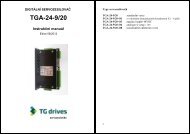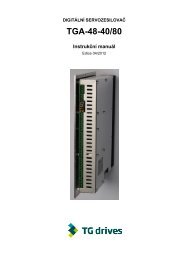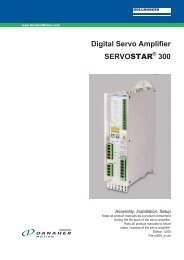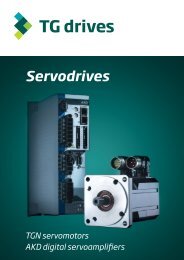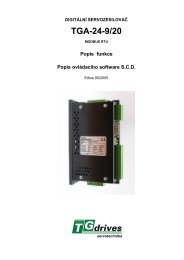Table of Contents - TG Drives
Table of Contents - TG Drives
Table of Contents - TG Drives
Create successful ePaper yourself
Turn your PDF publications into a flip-book with our unique Google optimized e-Paper software.
EXTENDED REGISTER GROUPS<br />
GROUP MEMBERS (GROUP 17)<br />
Group.Member Member<br />
No.<br />
Comm.Mode 0 RW<br />
Comm, Serial communication<br />
Range Ability Default<br />
The Comm.Mode at startup<br />
is determined by the LSB <strong>of</strong><br />
EEprom.7. Useful bits to set are 0, 1, 4 and 7. Set Bit 7 for all<br />
nodes in a daisy chain, except for one node. This setting<br />
determines the default node to communicate with at startup (i.e.<br />
before the first select sequence is sent.)<br />
Bit0 (1) Output from PL program disabled. All DISP, error messages, etc.<br />
are thrown away.<br />
Bit1 (2) Computer mode enabled on serial channel and terminal mode<br />
disabled.<br />
Bit2 (4) Echo <strong>of</strong>f. Special communication mode is enabled.<br />
The unit will not echo characters when typed and the DISP<br />
statement will only print the values, not the register name.<br />
Bit3 (8) Enables special behaviour <strong>of</strong> the computer mode protocoll for<br />
downloading applicaion SW. Normally the contents <strong>of</strong> the<br />
application memory is cleared by the downloadi process prior to<br />
tha actual transfer <strong>of</strong> new PL2 SW. This bit overides that<br />
behaviour so that partial download <strong>of</strong> PL2 SW is possiblee.<br />
Typically this can be used to speed up the dowmload <strong>of</strong> say a<br />
Camtable or another part <strong>of</strong> an application. The part <strong>of</strong> SW<br />
handled this way must be set to a specific part <strong>of</strong> the memory by<br />
using the .ORG directive.<br />
Bit4 (16) Xon/X<strong>of</strong>f protocol is enabled. X<strong>of</strong>f (Control-S) stops output; Xon<br />
(Control-Q) resumes output. If the node is deselected, the output<br />
is stopped when Xon/X<strong>of</strong>f is enabled; it is thrown away<br />
otherwise.<br />
Bit5 (32) Output is disabled due to a received X<strong>of</strong>f.<br />
Bit6 (64) A start <strong>of</strong> Select is detected (Control-Z) and the controller is now<br />
waiting for the next character in the sequence (the node<br />
number).<br />
Bit7 (128) Node is deselected. No text output can be made at the moment.<br />
If an output is attempted (DISP, etc.), the result is thrown away if<br />
Bit 4 = 0.<br />
If Bit 4 = 1, the result stays in the output buffer. If the output<br />
buffer becomes full, the executing DISP statement waits until the<br />
node is selected again.<br />
Comm.Baud 1 75..19200 RW<br />
Supported baud rates are: 75,150, 300, 600, 1200, 2400, 4800,<br />
9600 and 19200. (Only from Version 4.x. The baud rate value is<br />
now checked for validity before accepted.)<br />
Comm.Node 2 0..15 RW<br />
The node number to use when using the daisy-chain option. The<br />
initial value used after power up is stored in EEprom.6.Setting<br />
User's Manual 5.1 Inmotion Technologies AB<br />
Doc. No.9032 0027 01 (B), Rev. 11.07.2001<br />
131



